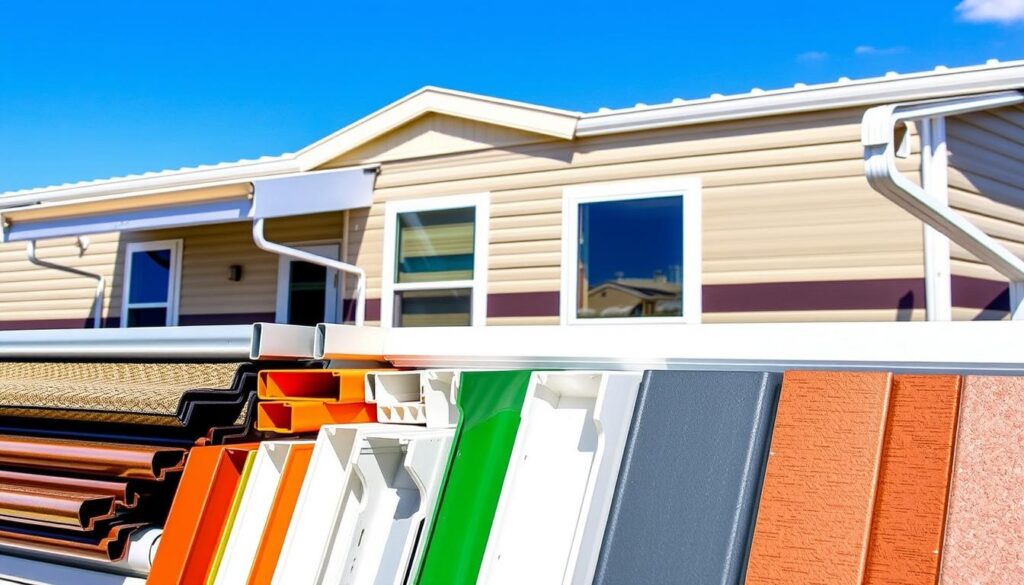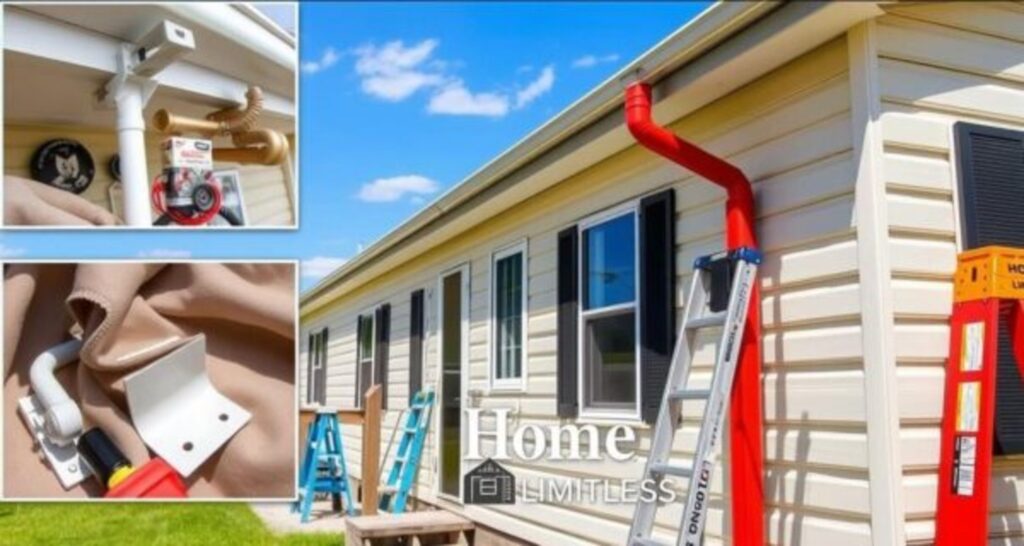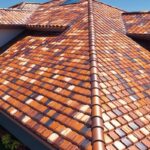Ever wondered why your mobile home needs gutters? Imagine rainwater pouring off your roof, into your foundation, and causing damage. Gutters are like superheroes, keeping your home safe from water harm. But how do you put them up yourself?
Mobile home gutters are vital for handling rainwater and keeping your home strong. Whether you choose aluminum, vinyl, or steel, installing them right is key. This guide will help you install them, keeping your home dry and safe.
Table of Contents
Key Takeaways
- Gutters protect mobile homes from water damage and foundation issues
- Choose durable materials like aluminum or vinyl for your gutter system
- Accurate measurements are crucial for proper gutter installation
- DIY installation can save money, but professional help ensures optimal performance
- Regular maintenance is essential for the longevity of your gutter system
- Consider local climate when selecting gutter materials and installation methods
Understanding the Importance of Gutters for Mobile Homes
Gutters are key to keeping mobile homes safe from water damage. Many mobile homes are built elsewhere and then moved to their final spot. They sit on cement slabs, sometimes with footers. Without gutters, these homes are at risk.
Protection Against Water Damage
Mobile home roof drainage systems are vital to stop water from getting inside. Without gutters, homes are more likely to get mold, mildew, and rot. Fixing these problems can cost a lot more than installing gutters.

Preserving the Foundation and Skirting
Good gutter solutions keep mobile homes stable. They stop water from gathering around the foundation, which can cause problems. Fixing foundation issues can cost around $8,000, but gutters are much cheaper.
Managing Rainwater and Stormwater
Managing rainwater well is crucial for mobile homes. Modern gutters can handle 33% more water than old ones. Using bigger downspouts, like 4″x3″ models, can move twice as much water. This helps manage water better.
| Feature | Benefit |
|---|---|
| Advanced Gutter Systems | 33% more water capacity |
| 4″x3″ Downspouts | 2x water diversion capability |
| Proper Gutter Installation | Prevents mold, leaks, foundation issues |
Mobile Home Gutters: Types and Materials
Choosing the right gutters for your prefab home is key for keeping water away. Different materials have their own perks, fitting various needs and budgets.
Aluminum Gutters
Aluminum gutters are a favorite for prefab homes. They’re light and don’t rust, making them simple to put up and care for. About 41% of homeowners pick aluminum for its lasting quality and value.
Vinyl Gutters
Vinyl gutters are a hit in milder climates. They’re cheap and easy to install, making up 27% of gutter choices in these areas. Vinyl is great for DIY fans and fights off corrosion well.
Steel Gutters
Steel gutters are the best for tough weather. They handle heavy snow and extreme cold better than others. Steel is a wise pick for lasting through harsh conditions.
Copper and Zinc Options
Copper gutters, chosen by 12% of homeowners, are unmatched in beauty and durability. They’re ideal for fancy homes and historic fixes. Zinc gutters also offer great looks, getting a protective layer over time.

| Gutter Material | Popularity | Durability | Cost |
|---|---|---|---|
| Aluminum | 41% | High | Moderate |
| Vinyl | 27% | Moderate | Low |
| Steel | 20% | Very High | High |
| Copper | 12% | Excellent | Very High |
Planning Your Gutter Installation Project
Planning is key for a successful gutter installation in your mobile home. Start by looking at the area around your home to find the best spots for water to flow. This is important for keeping your gutters in good shape.
Think about using splash blocks or underground pipes to control water flow. This helps prevent erosion near downspout outlets. If your gutters are over 20 years old or damaged, it’s time to replace them.
Gutter installation costs can vary a lot, from $3 to $30 per foot. Most people spend $1,000 to $2,000 for a full system. When planning, consider the materials like vinyl, steel, or aluminum. Proper planning can help avoid expensive problems later.
Draw a sketch of your home, marking where gutters and downspouts will go. Count the roof corners to figure out how many elbows you need. Gutters should slope down for good drainage. This careful planning helps manage water and keeps your home’s exterior in good shape.
“A well-planned gutter system is your mobile home’s first line of defense against water damage.”
By planning well, you’ll make the installation process smoother. This also helps with long-term gutter repair and maintenance.
Essential Tools and Materials for DIY Gutter Installation
Installing mobile home gutters needs careful planning and the right tools. Let’s look at the essential tools and materials for a successful DIY gutter installation on manufactured home gutter systems.
Tools Checklist
Before starting, gather these crucial tools:

Materials List
For mobile home gutters, you’ll need:
- Gutter sections (5″ K-Style Aluminum is common)
- Downspouts
- Brackets and hangers
- End caps
- Connectors and corner pieces
- Screws and rivets
- Sealant for gutters
Plan to add 10% extra for mistakes or unexpected issues. For every 20-30 feet of gutter, use one downspout. Aluminum gutters cost between $4 to $9 per linear foot. Most projects cost $1,050 to $2,400.
Safety Equipment
Safety is the most important thing when installing manufactured home gutter systems. Don’t forget these items:
- Sturdy work boots
- Hearing protection
- Work gloves
- Safety harness (for steep roofs)
Remember, proper planning and safety are key to a successful mobile home improvement project. With the right tools and materials, you’ll be ready to install your new gutter system efficiently and safely.
| Item | Quantity | Purpose |
|---|---|---|
| 5″ K-Style Aluminum Gutters | As needed (+ 10% extra) | Main gutter sections |
| Downspouts | 1 per 20-30 feet of gutter | Water drainage |
| Brackets and Hangers | Every 2-3 feet | Gutter support |
| Sealant | 1-2 tubes | Waterproofing joints |
Measuring and Calculating Gutter Requirements
Getting the right measurements is crucial for installing modular home rain gutters. Let’s go through the steps to make sure you get it right the first time.
Measuring Roof Dimensions
First, measure the length of each roof edge where you’ll put gutters. Remember to include corners and angles. For RV gutters, measure the roof’s entire perimeter.
Determining Downspout Locations
Find the best spots for downspouts, usually at corners and every 40 feet. For modular homes, think about the layout and landscaping when picking spots.
Calculating Material Quantities
Figure out how much gutter you need, adding 10% for waste and mistakes. Here’s a simple guide for sizing:
- 5-inch K-style gutters handle up to 5,520 square feet of roof area
- 6-inch K-style gutters manage up to 7,960 square feet
- For RV gutter installation, 5-inch half-round gutters suit up to 2,500 square feet
For downspouts, a 2-by-3 inch rectangular downspout handles about 600 square feet. A 3-inch round one manages 706 square feet. Adjust based on your roof size and local rainfall.
Preparing Your Mobile Home for Gutter Installation
Before you start installing gutters on your mobile home, it’s important to prepare well. First, check the fascia board for any rot or damage. This is a key step for good trailer gutter solutions.
To fix expanded fastener holes, use wooden dowels and glue. For unused holes, fill them with exterior wood filler and paint over. If you’re replacing gutters, clean the area first for a smooth installation.
Make sure the area around your mobile home is clear. This is important for safe ladder use during installation. A clean workspace helps with faster gutter installation.
“Proper preparation is half the battle when it comes to installing gutters on a mobile home.”
Remember, gutters should slope one inch for every 20 feet to drain water well. You might need two to four downspouts for best results. Proper anchoring of your mobile home is also key for safety and stability.
| Preparation Step | Purpose |
|---|---|
| Inspect fascia | Identify and repair damage |
| Fill holes | Ensure secure gutter attachment |
| Clear debris | Create clean working surface |
| Clear surroundings | Ensure safe ladder placement |
By taking these steps, you’ll lay a strong foundation for your gutter installation. This ensures your home is well-protected from water damage.
Step-by-Step Guide to Installing Mobile Home Gutters
Installing gutters on your prefab home is key to avoiding water damage. This guide will help you set up a portable home water diversion system. This way, your mobile home will stay dry and safe.
Installing Downspouts
Begin by setting downspout outlets at your roof’s corners. Assemble the downspout sections, making sure they hit the ground. For best water flow, keep a slope of 1/4 inch for every 10 feet of gutter.
Attaching Gutter Brackets
Place gutter brackets along the roof edge, about 2 feet apart. This supports your prefab home gutter replacement system well. Use a level to keep everything straight.
Cutting and Joining Gutter Sections
Measure and cut gutter sections to fit your roof. Use sealant and screws to join them, making a tight seal. High-quality materials make your system last longer.
Securing Gutters to Brackets
Attach the gutter sections to the brackets carefully. Make sure they’re aligned right and follow the slope for good water flow.
Connecting Gutters to Downspouts
Lastly, link your gutters to the downspouts with elbows and extensions as needed. This finishes your portable home water diversion system.
After you’re done, test your gutter system with a hose. Look for leaks and check the water flow. While DIY is doable, pros offer warranties and follow local codes.
“A well-installed gutter system is your mobile home’s first line of defense against water damage.”
Troubleshooting Common Gutter Installation Issues
Installing gutters on your mobile home can be tricky. Let’s explore some common issues you might face during modular housing gutter repair and mobile residence gutter maintenance.
Sagging gutters are a frequent problem. They can cause incorrect drainage and foundational rot. The good news? Fixing sagging gutters often takes just 10 minutes by replacing gutter hangers.
Leaking gutters pose another challenge. They lead to foundation erosion and gutter corrosion. Repairing leaks is usually simple, requiring only plastic roofing cement and a putty knife.
Improper gutter slope results in standing water and system stress. To fix this, rehang the gutters ensuring a slope of 1/4-inch per 10 feet.
Clogged gutters attract pests and cause hardware failure. Regular cleaning prevents this issue. Consider installing gutter guards for long-term protection.
| Issue | Causes | Solution |
|---|---|---|
| Sagging Gutters | Weak hangers, heavy debris | Replace gutter hangers |
| Leaking Gutters | Cracks, holes, loose joints | Apply roofing cement |
| Improper Slope | Incorrect installation | Rehang gutters with correct slope |
| Clogged Gutters | Debris accumulation | Regular cleaning, install guards |
Remember, prevention is key in mobile residence gutter maintenance. Clean gutters regularly, check for leaks, and inspect the pitch. After storms, look for damage to prevent future issues in your modular housing gutter system.
Maintenance Tips for Your New Mobile Home Gutter System
Proper care of your mobile home gutters ensures they function effectively for years. A well-maintained gutter system protects your home from water damage and preserves its foundation.
Regular Cleaning Routines
Clean your manufactured home gutter systems at least once a year. In areas with heavy rainfall or snowfall, aim for twice yearly. Remove leaves, twigs, and debris to prevent clogs. This simple task can save you from costly repairs down the line.
Inspecting for Damage
Regularly check your mobile home gutters for signs of wear or damage. Look for cracks, loose connections, or sagging sections. Address these issues promptly to maintain the integrity of your gutter system.
Seasonal Maintenance Considerations
Prepare your gutters for different seasons. Before winter, ensure proper drainage to prevent ice dams. In spring, clear out any debris that accumulated during winter. This seasonal approach keeps your manufactured home gutter systems in top shape year-round.
| Season | Maintenance Task |
|---|---|
| Spring | Clear winter debris, check for damage |
| Summer | Clean gutters, inspect for leaks |
| Fall | Remove leaves, ensure proper flow |
| Winter | Check for ice dams, clear snow buildup |
Remember, consistent maintenance of your mobile home gutters not only extends their lifespan but also protects your home’s structural integrity. By following these tips, you’ll keep your gutter system functioning efficiently for years to come.
Conclusion
Installing modular home rain gutters is key to protecting your mobile home from water damage. This DIY project can save you money and offer long-lasting benefits. With the right tools, materials, and careful planning, you can successfully install rv gutters.
Remember, keeping your gutters clean is important. Clean them twice a year, in spring and fall, to prevent clogs and damage. Make sure the gutter pitch is between 1/4 inch and 1/2 inch per foot for good water flow. Also, place downspouts at your home’s corners, extending at least 6 feet away to prevent water pooling.
Choosing the right gutter material is crucial. Aluminum gutters are durable, while vinyl options are budget-friendly and easy to install. Think about material, size, style, warranty, and quality before buying. By following this guide and prioritizing safety, you’ll keep your mobile home safe from water damage, mold, and structural issues for years.








7 thoughts on “How to Install Mobile Home Gutters?: Step-by-Step DIY Guide”